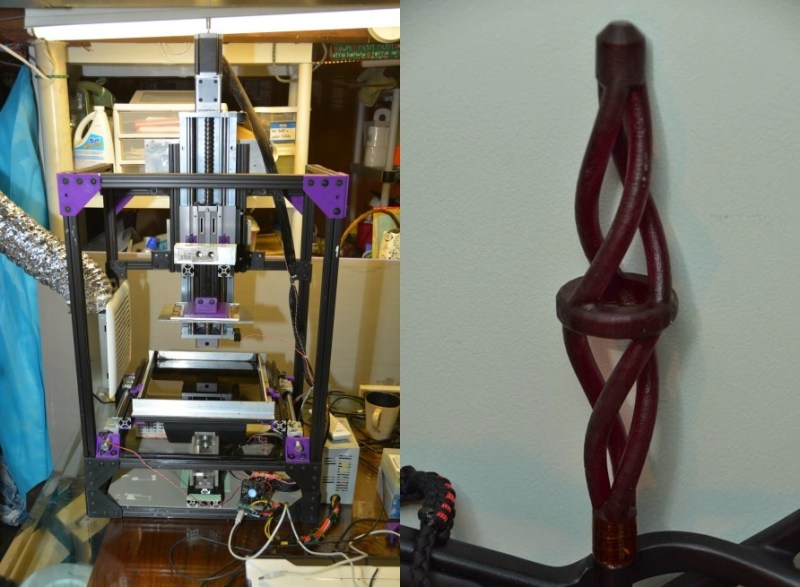Resin based 3D printers (SLA) are the next big thing, and while they may seem daunting at first, in some ways they are actually simpler than FDM machines with less moving parts! Loosely following an Instructable, [Dan Beaven] has just finished putting together his own home-made 3D DLP Printer, and it’s bloody brilliant.
He owes a lot of thanks to [Tristram Budel] and his incredibly detailed Instructables guide on building a 3D DLP printer, but [Dan] has also added quite a bit of his own flair to the build. Most notably is his method of separating layers from the vat of resin — most designs tilt the bed slightly to counter the suction forces, but his slides the vat back and forth along the Y-axis, which seems to work extremely well.
The printer is built out of 1″ T-slot aluminum and has a NEMA 17 motor that provides the Y-axis movement along two linear rods for the vat. The Z-axis stage uses a NEMA 23 motor and has a whopping 14″ of travel. Combined with a 104mm x 204mm build plate, this thing can print some decently sized parts!
To cure the resin, he’s using a 1080p DLP projector with no modifications. To conserve space, it is mounted at a 90 degree angle, and uses a small mirror to reflect the image onto the build plate inside of the vat. To pump the resin in and out of the vat, he’s using an industrial peristaltic pump he bought off eBay — a word to the wise, it needs to be flushed with isopropyl alcohol after each use! He learned the hard way…
For more info on printing in resin, don’t forget to check out our column on 3D Printering: You Want UV Resin?
















Super cool!! Now I know what my next printer will be!
But, I have no time or money :/
I’m a student xD
Lobby your school to buy / build one !
I’m currently building one. What cost the most is the dlp projector. I’m struggling in finding not-so-expensive dlp projector with a good light power.
Thanks. Youd be surprised what you can accomplish with trades on craigslist.com. Sometimes when i have little to no money for projects trading gets me part or all of the way there. The acrylic and aluminum vat sides for my build were from trades.
The linear rails for the y axis were from an old hp plotter i got for free.
This is only the beginning, there are indications that resin printers could print REALLY REALLY FAST!
It looks pretty awesome, I really like his solution for handling the liquid resin. I bet the build plate area could be increased by applying high res projectors with high light intensity (for example a 4k projector with at least 10000 ansi lumen) and it can cure the resin faster as well. I’m going to build one soon, the mechanics are simpler and cheaper than in FDM printers, the light source is the key point of the project. thanks for sharing the great stuff, it’s truly inspirational and useful for the further improvements. btw, all the patents for the SLA/SLS technology owned by 3d Systems have been expired, right?:)
“Each 100micron layer – 6.25 seconds”
That was actually faster than I expected. 5-6 seconds is the MIN time I spend on a layer with my FDM printers (UM, UM2). And since the resin printers do the whole layer at once it will end up being significantly faster as the area of each layer goes up.
The whole process is still pretty messy though which is a shame. But, given a bit more time that will be sorted out I’m sure.
sneakypoo, you’re entirely right about it being messy. The peristaltic pump has made a huge difference transferring the resin back and forth from container to vat. But, you still have to clean the build plate everytime and the vat whenever resin needs to be switched. I have a set of dish gloves I use for this; the resin still gets all over things.
It is important to note that the uncured photopolymers are sensitizing agents and care should be taken when handling resin or parts that are not fully cured. You can dispose of resin by setting it in the sun to harden or build a UV curing oven.
sir
what are uss a projector print rct100 resin ya cremica resin
Are you looking for the exposure time settings?
Has anyone tried this printer, what about running it based on a Raspberry Pi, Like those Raspberry Pi based printers?
Is there a way I can determine which is a good projector form a bad one when building a resin printer? TIA
It really comes down to how much UV light comes out. Unless you get resin wifh a photoinitiator thats sensitive to visible light. Many DLP based projectors output enough in the 400 to 420nm wavelength to cure the resin without too high of exposure times.
I tried to build one but the projector I have doesn’t cure the resin correctly, I got white maker juice. I can’t tell how much UV light it produces.
Walk a ginger in front of it, sunburn = reasonable UV output :-D
LOL!! Witty.
Can someone clue me in as to why this is unpossible with an LCD projector, blocks UV light???